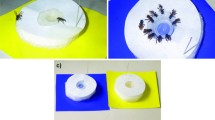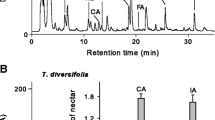Abstract
Various nectar components have a repellent effect on flower visitors, and their adaptive advantages for the plant are not well understood. Persea americana (avocado) is an example of a plant that secretes nectar with repellent components. It was demonstrated that the mineral constituents of this nectar, mainly potassium and phosphate, are concentrated enough to repel honey bees, Apis mellifera, a pollinator often used for commercial avocado pollination. Honey bees, however, are not the natural pollinator of P. americana, a plant native to Central America. In order to understand the role of nectar minerals in plant—pollinator relationships, it is important to focus on the plant’s interactions with its natural pollinators. Two species of stingless bees and one species of social wasp, all native to the Yucatan Peninsula, Mexico, part of the natural range of P. americana, were tested for their sensitivity to sugar solutions enriched with potassium and phosphate, and compared with the sensitivity of honey bees. In choice tests between control and mineral-enriched solutions, all three native species were indifferent for mineral concentrations lower than those naturally occurring in P. americana nectar. Repellence was expressed at concentrations near or exceeding natural concentrations. The threshold point at which native pollinators showed repellence to increasing levels of minerals was higher than that detected for honey bees. The results do not support the hypothesis that high mineral content is attractive for native Hymenopteran pollinators; nevertheless, nectar mineral composition may still have a role in regulating flower visitors through different levels of repellency.



Similar content being viewed by others
Explore related subjects
Discover the latest articles and news from researchers in related subjects, suggested using machine learning.References
Adler LS (2000) The ecological significance of toxic nectar. Oikos 91:409–420
Adler LS, Irwin RE (2005) Ecological costs and benefits of defenses in nectar. Ecology 86:2968–2978
Afik O, Dag A, Kerem Z, Shafir S (2006a) Analyses of avocado (Persea americana) nectar properties and their perception by honey bees (Apis mellifera). J Chem Ecol 32:1949–1963
Afik O, Dag A, Shafir S (2006b) The effect of avocado (Persea americana) nectar composition on its attractiveness to honey bees (Apis mellifera). Apidologie 37:317–325
Afik O, Dag A, Shafir S (2007) The perception of avocado (Persea americana: Lauraceae) bloom by the honey bee (Apis mellifera: Hymenoptera). Entomol Gen 30:135–153
Afik O, Dag A, Shafir S (2008) Honeybee, Apis mellifera, round dance is influenced by trace components of floral nectar. Anim Behav 75:371–377
Bänziger H, Boongird S, Sukumalanand P, Bänziger S (2009) Bees (Hymenoptera: Apidae) that drink human tears. J Kansas Entomol Soc 82:135–150
Barclay RMR (2002) Do plants pollinated by flying fox bats (Megachiroptera) provide an extra calcium reward in their nectar? Biotropica 34:168–171
Bouchard S, Vonhof MJ, Fenton MB, Monette G (2000) Nutrient preferences of Brazilian hummingbirds. Wilson Bull 112:558–562
Can-Alonzo C, Quezada-Euan JJG, Xiu-Ancona P, Moo-Valle H, Valdovinos-Nunez GR, Medina-Peralta S (2005) Pollination of ‘criollo’ avocados (Persea americana) and the behaviour of associated bees in subtropical Mexico. J Apic Res 44:3–8
Carroll SP, Moore L (1993) Hummingbirds take their vitamins. Anim Behav 46:817–820
Carter C, Shafir S, Yehonatan L, Palmer RG, Thornburg R (2006) A novel role for proline in plant floral nectars. Naturwissenschaften 93:72–79
Eardley CD, Mansell MW (1996) The natural occurrence of insect pollinators in an avocado orchard. SAAGA Yearbook 19:36–38
Escuredo O, Seijo MC, Fernandez-Gonzalez M (2011) Descriptive analysis of Rubus honey from the north-west of Spain. Int J Food Sci Technol 46:2329–2336
Galen C (1983) The effect of nectar thieving ants on seedset in floral scent morphs of Polemonium viscosum. Oikos 41:245–249
Gazit S, Degani C (2002) Reproductive biology. In: Whiley AW, Schaffer B, Wolstenholme BN (eds) The avocado: Botany, production and uses. CAB International, Wallingford, pp 101–133
Hagler JR (1990) Honey bee (Apis mellifera L) response to simulated onion nectars containing variable sugar and potassium concentrations. Apidologie 21:115–121
Hagler JR, Buchmann SL (1993) Honey-bee (Hymenoptera, Apidae) foraging responses to phenolic-rich nectars. J Kansas Entomol Soc 66:223–230
Hiebert SM, Calder WA (1983) Sodium, potassium, and chloride in floral nectars: energy-free contributions to refractive-index and salt balance. Ecology 64:399–402
Ish-Am G, Eisikowitch D (1998) Low attractiveness of avocado (Persea americana Mill.) flowers to honeybees (Apis mellifera L.) limits fruit set in Israel. J Hortic Sci Biotechnol 73:195–204
Ish-Am G, Barrientos-Priego AF, Castaneda-Vildozola A, Gazit S (1999) Avocado (Persea americana Mill.) pollinators in its region of origin. Rev Chapingo Ser Hortic 5:137–143
Johnson S, Hargreaves AL, Brown M (2006) Dark, bitter-tasting nectar functions as a filter of flower visitors in a bird-pollinated plant. Ecology 87:2709–2716
Junker R, Chung AYC, Bluthgen N (2007) Interaction between flowers, ants and pollinators: additional evidence for floral repellence against ants. Ecol Res 22:665–670
Kessler D, Baldwin IT (2006) Making sense of nectar scents: the effects of nectar secondary metabolites on floral visitors of Nicotiana attenuata. Plant J 49:840–854
Kessler D, Gase K, Baldwin IT (2008) Field experiments with transformed plants reveal the sense of floral scents. Science 321:1200–1202
Knight RJ (2002) History, distribution and uses. In: Whiley AW, Schaffer B, Wolstenholme BN (eds) The avocado: Botany, production and uses. CAB International, Wallingford, pp 1–14
Liu FL, Fu WJ, Yang DR, Peng YQ, Zhang XW, He JZ (2004) Reinforcement of bee-plant interaction by phenolics in food. J Apic Res 43:155–157
Liu F, Chen J, Chai J, Zhang X, Bai X, He D, Roubik DW (2007) Adaptive functions of defensive plant phenolics and a non-linear bee response to nectar components. Funct Ecol 21:96–100
London-Shafir I, Shafir S, Eisikowitch D (2003) Amygdalin in almond nectar and pollen—facts and possible roles. Plant Syst Evol 238:87–95
Lorenzon MCA, Matrangolo CAR (2005) Foraging on some nonfloral resources by stingless bees (Hymenoptera, Meliponini) in a Caatinga region. Braz J Biol 65:291–298
Nicolson SW, W.-Worswick PV (1990) Sodium and potassium concentrations in floral nectars in relation to foraging by honey bees. S Afr J Zool 25:93–96
Perez-Balam J, Quezada-Euan JJG, Alfaro-Bates R, Medina S, McKendrick L, Soro A, Paxton RJ (2012) The contribution of honey bees, flies and wasps to avocado (Persea americana) pollination in southern Mexico. J Poll Ecol 8:42–47
Petanidou T (2007) Ecological and evolutionary aspects of floral nectars in Mediterranean habitats. In: Nicolson SW, Nepi M, Pacini E (eds) Nectaries and nectar. Springer, Dordrecht, pp 343–376
Plesser Y (2007) Factors that affect the attraction of bumblebees (Bombus terrestris) to the cotton plant (Gossypium spp.). M.Sc. Dissertation, The Hebrew University of Jerusalem
Rhoades DF, Bergdahl JC (1981) Adaptive significance of toxic nectar. Am Nat 117:798–803
Roubik DW (1989) Ecological and natural history of tropical bees. Cambridge University Press, New York
Shafir S (1996) Color discrimination conditioning of a wasp, Polybia occidentalis (Hymenoptera: Vespidae). Biotropica 28:243–251
Silva EM, Dean BB (2000) Effect of nectar composition and nectar concentration on honey bee (Hymenoptera: Apidae) visitations to hybrid onion flowers. J Econ Entomol 93:1216–1221
Singaravelan N, Nee’man G, Inbar M, Izhaki I (2005) Feeding responses of free-flying honeybees to secondary compounds mimicking floral nectars. J Chem Ecol 31:2791–2804
Soto VC, Maldonado IB, Gil RA, Peralta IE, Silva MF, Galmarini CR (2013) Nectar and flower traits of different onion male sterile lines related to pollination efficiency and seed yield of F1 hybrids. J Econ Entomol 106:1386–1394
Souza B, Roubik D, Barth O, Heard T, Enriquez E, Carvalho C, Villas-Bôas J, Marchini L, Locatelli J, Persano-Oddo L, Almeida-Muradian L, Bogdanov S, Vit P (2006) Composition of stingless bee honey: setting quality standards. Interciencia 31:867–875
Stephenson AG (1981) Toxic nectar deters nectar thieves of Catalpa speciosa. Am Midl Nat 105:381–383
Tan K, Wang ZW, Yang MX, Fuchs S, Luo LJ, Zhang ZY, Li H, Zhuang D, Yang S, Tautz J, Beekman M, Oldroyd BP (2012) Asian hive bees, Apis cerana, modulate dance communication in response to nectar toxicity and demand. Anim Behav 84:1589–1594
Vit P, Persano-Oddo L, Marano ML, Salas de Mejiasc E (1998) Venezuelan stingless bee honeys characterized by multivariate analysis of physicochemical properties. Apidologie 29:377–389
Vithanage V (1990) The role of the European honeybee (Apis mellifera L.) in avocado pollination. J Hortic Sci 65:81–86
Waller GD, Carpenter EW, Ziehl OA (1972) Potassium in onion nectar and its probable effect on attractiveness of onion flowers to honey bees. J Am Soc Hortic Sci 97:535–539
White JW (1992) Honey. In: Graham JM (ed) The hive and the honey bee. Dadant and Sons, Hamilton, pp 869–925
Wright GA, Baker DD, Palmer MJ, Stabler D, Mustard JA, Power EF, Borland AM, Stevenson PC (2013) Caffeine in floral nectar enhances a pollinator’s memory of reward. Science 339:1202–1204
Acknowledgments
We thank Horacio Gomez Chan who allowed us to work in his avocado orchard and Cecil Smith from the Georgia Museum of Natural History who identified the wasps. The research was partly supported by a Vaadia-BARD postdoctoral fellowship, FI-407-2008 from BARD, the United States-Israel Binational Agricultural Research and Development Fund (O.A.). The experiments at UADY were partly funded by the project MUTUAL (Foncicyt 2008-94293).
Author information
Authors and Affiliations
Corresponding author
Rights and permissions
About this article
Cite this article
Afik, O., Delaplane, K.S., Shafir, S. et al. Nectar Minerals as Regulators of Flower Visitation in Stingless Bees and Nectar Hoarding Wasps. J Chem Ecol 40, 476–483 (2014). https://doi.org/10.1007/s10886-014-0455-8
Received:
Revised:
Accepted:
Published:
Issue Date:
DOI: https://doi.org/10.1007/s10886-014-0455-8




